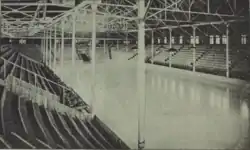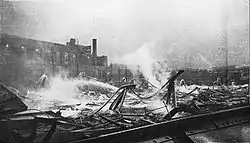Montreal Arena
The Montreal Arena, also known as Westmount Arena, was an indoor arena located in Westmount, Quebec, Canada on the corner of St. Catherine Street and Wood Avenue. It was likely one of the first arenas designed expressly for hockey, opening in 1898. It was the primary site of amateur and professional ice hockey in Montreal until 1918.
Westmount Arena | |
 | |
| Location | St. Catherine Street and Wood Avenue, Westmount |
|---|---|
| Owner | Canadian Arena Company |
| Capacity | 4,300 10,000 (temporary) |
| Surface | Natural ice (1898) Artificial (1915) |
| Construction | |
| Broke ground | 1898 |
| Opened | December 31, 1898 |
| Closed | 1918 |
| Demolished | 1918 |
| Tenants | |
| Montreal Canadiens (NHA, NHL) (1911–1918) Montreal Wanderers (NHA, NHL) (1904–1909, 1911–1918) | |
Description
Opened on December 31, 1898, it held 10,000 people, 4300 seated. It held a refreshment buffet and smoking rooms, with rugs available for rental to sit on.[1] It is likely the third arena designed expressly for ice hockey, after the St. Nicholas Rink in New York City, and the Dey's Skating Rink in Ottawa, which both opened in 1896.
The ice rink ends were not squared off but rounded off. The ends were somewhat semi-circular, possibly the first design of its kind. A puck could be shot along the outside rim, slide along the corners, pass behind the goal and come out the other side. That type of shot is common in hockey today and is called "rimmed around." The rounded-corners design spread to other arenas. In 1902, after Ottawa's Dey Rink was demolished due to a storm, it was rebuilt with rounded ends to match the Montreal Arena.[2] The fence along the ice surface was increased in height to 4 feet (1.2 m), an increase from the Victoria Skating Rink's one foot high boards.[3] The first artificial ice-making plant in Montreal was installed in the Arena in 1915.[4]
The owners of the Montreal Arena, the Canadian Arena Company, later built the Arena Gardens in Toronto, and operated the Toronto NHL franchise in 1917–18. Principals of the Arena Company, such as William Northey, would later be involved in the building of the Montreal Forum and the founding of the Montreal Maroons.
The Montreal Canadiens won their first (pre-NHL) Stanley Cup in this building on March 30, 1916 against the Portland Rosebuds.
Fire

A fire started in the ice-making plant causing the arena to burn down on January 2, 1918. It began mid-day, when the only people in the building were the superintendent James McKeene and his family, who were eating in their apartment on the north side of the structure; all escaped safely but they lost most of their belongings, as well as a car stored in the annex.[5] Damage was estimated at $150,000, including the uniforms and sticks of the Wanderers and Canadiens, with only a third covered by insurance.[5] The blaze led the Montreal Wanderers, already on shaky grounds, to disband within days and the Canadiens to move back to Jubilee Arena, which itself would be destroyed by fire, the next year.[5] In 1924, the new Montreal Forum was built one block to the east.
Today
A condominium building currently sits on the site. Previously a warehouse had been on the site after the fire that destroyed the arena.
Usage
At first, it hosted the Montreal senior men's amateur hockey teams of the Amateur Hockey Association of Canada, including the Montreal, Shamrock and Victoria hockey clubs. The Wanderers would start play there in 1904. Later, it served as the home rink for the Montreal Canadiens of the National Hockey Association and National Hockey League from 1911 until 1918.
In 1907, it was the site of one of hockey's first player brawls. On January 12, 1907, the game between the heated rivals Ottawa Hockey Club and the Montreal Wanderers degenerated into a free for all. Ottawa players Charles Spittal, Alf Smith and Harry Smith each knocked out a Montreal player cold and received game misconducts. Cecil Blachford, Ernest Johnson and Hod Stuart all required hospital treatment. Despite the injuries, the Wanderers won the game 4–2. The ECAHA convened a week later to consider discipline for the Ottawa players and when no agreement was found, league president McRobie resigned. When Ottawa returned for a January 26 against the Montreal Victorias, Spittal and the Smiths were arrested for assault, each eventually paying $20 fines.[6]
The newly formed NHL played its first game in the Arena on December 19, 1917, with the Wanderers earning a 10-9 win over the newly established Toronto Arenas.[5] A French language newspaper ad re-discovered in 2017 established that the Montreal game started at 8:15 pm, ahead of another game that same night in Ottawa scheduled to begin at 8:30 pm.[7] Wanderers defenceman Dave Ritchie scored the league's first goal early in the game.[7]
The building was also used for exhibition space. Horse shows, car shows, motor-boat displays, concerts, and bazaars were held. New York's Metropolitan Opera performed at the arena, as well as singers such as Melba, Caruso, Calve and Albani.[8]
See also
References
- Kitchen, Paul (2008). Win, Tie or Wrangle. Manotick, Ontario: Penumbra Press. ISBN 978-1-897323-46-5.
- Vigneault, Michel (1997). "Montreal Ice-Hockey Rinks:1875-1917". Hockey Research Journal. Vol. 3.
- Notes
- Coleman, Charles (1966). Trail of the Stanley Cup, vol 1., 1893-1926 inc.
- Kitchen(2008), p. 112
- Vigneault 1997, p. 8.
- Vigneault 1997, p. 10.
- Prewitt, Alex (February 11, 2017). "The most famous fire in hockey history: The day the Montreal Arena burned down". Sports Illustrated. Retrieved February 9, 2017.
- Stubbs, Dave (January 12, 2007). "It was butchery, not sport, in Westmount". Montreal Gazette. Archived from the original on October 24, 2012.
- Boswell, Randy (April 16, 2017). "Solving the mystery of the NHL's 1st game". CBC News. Retrieved April 16, 2017.
- Vigneault 1997, pp. 8–9.